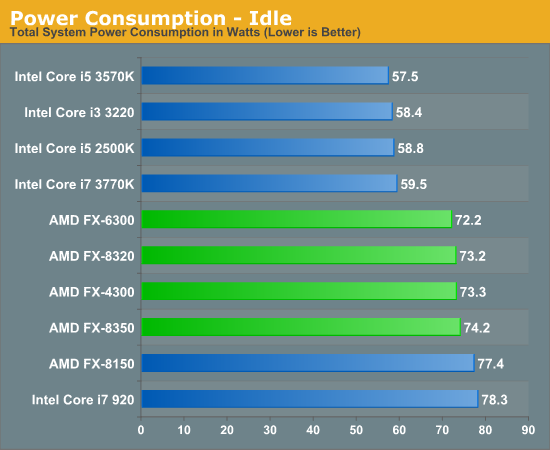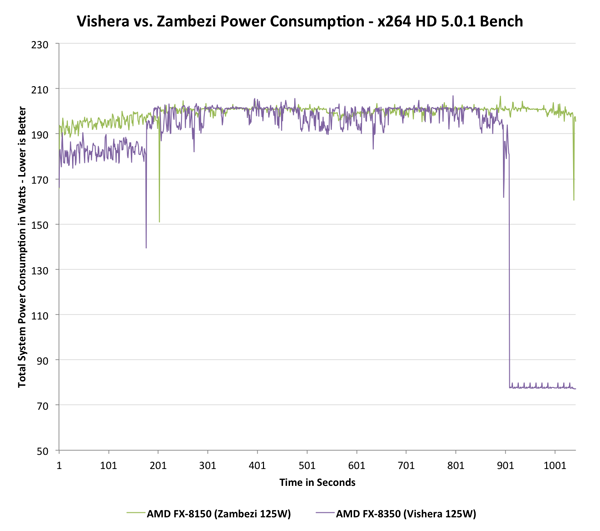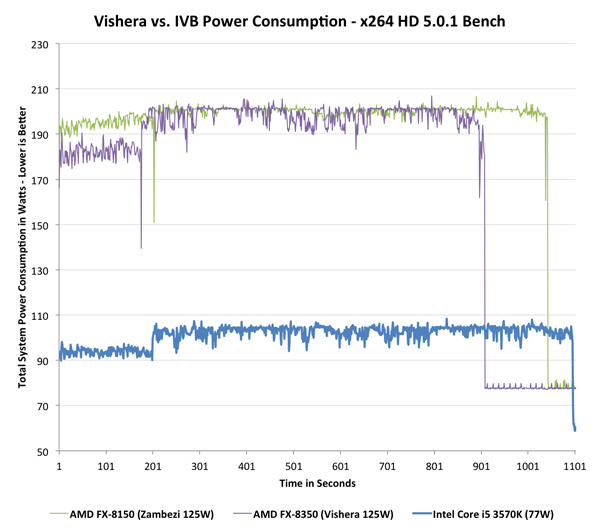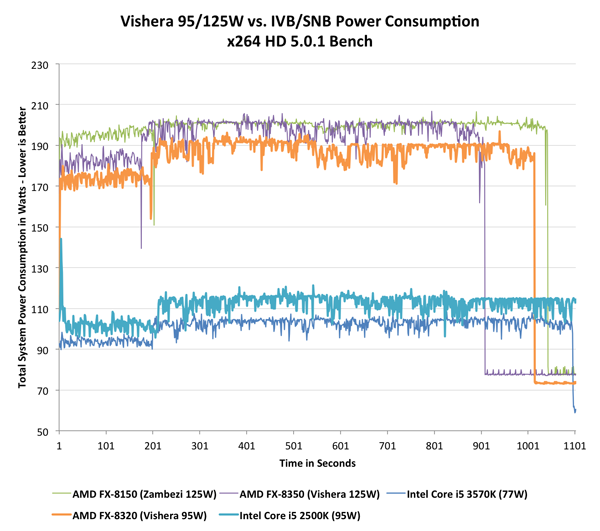The Vishera Review: AMD FX-8350, FX-8320, FX-6300 and FX-4300 Tested
by Anand Lal Shimpi on October 23, 2012 12:00 AM ESTPower Consumption
With Vishera, AMD was in a difficult position: it had to drive performance up without blowing through its 125W TDP. As the Piledriver cores were designed to do just that, Vishera benefitted. Remember that Piledriver was predominantly built to take this new architecture into mobile. I went through the details of what makes Piledriver different from its predecessor (Bulldozer) but at as far as power consumption is concerned, AMD moved to a different type of flip-flop in Piledriver that increased complexity on the design/timing end but decreased active power considerably. Basically, it made more work for AMD but resulted in a more power efficient chip without moving to a dramatically different architecture or new process node.
In mobile, AMD used these power saving gains to put Piledriver in mobile APUs, a place where Bulldozer never went. We saw this with Trinity, and surprisingly enough it managed to outperform the previous Llano generation APUs while improving battery life. On desktops however, AMD used the power savings offered by Piledriver to drive clock speeds up, thus increasing performance, without increasing power consumption. Since peak power didn't go up, overall power efficiency actually improves with Vishera over Zambezi. The chart below illustrates total system power consumption while running both passes of the x264 HD (5.0.1) benchmark to illustrate my point:
In the first pass Vishera actually draws a little less power, but once we get to the heavier second encode pass the two curves are mostly indistinguishable (Vishera still drops below Zambezi regularly). Vishera uses its extra frequency and IPC tweaks to complete the task sooner, and drive down to idle power levels, thus saving energy overall. The picture doesn't look as good though if we toss Ivy Bridge into the mix. Intel's 77W Core i5 3570K is targeted by AMD as the FX-8350's natural competitor. The 8350 is priced lower and actually outperforms the 3570K in this test, but it draws significantly more power:
The platforms aren't entirely comparable, but Intel maintains a huge power advantage over AMD. With the move to 22nm, Intel dropped power consumption over an already more power efficient Sandy Bridge CPU at 32nm. While Intel drove power consumption lower, AMD kept it constant and drove performance higher. Even if we look at the FX-8320 and toss Sandy Bridge into the mix, the situation doesn't change dramatically:
Sandy Bridge obviously consumes more than Ivy Bridge, but the gap between a Vishera and any of the two Intel platforms is significant. As I mentioned earlier however, this particular test runs quicker on Vishera however the test would have to be much longer in order to really give AMD the overall efficiency advantage.
If we look at average power over the course of the two x264 encode passes, the results back up what we've seen above:

As more client PCs move towards smaller form factors, power consumption may become just as important as the single threaded performance gap. For those building in large cases this shouldn't be a problem, but for small form factor systems you'll want to go Ivy Bridge.
Note that idle power consumption can be competitive, but will obviously vary depending on the motherboard used (the Crosshair Formula V is hardly the lowest power AM3+ board available):














250 Comments
View All Comments
frozen ox - Tuesday, October 23, 2012 - link
Yes please! This is the only reason I even read reviews about CPUs with more than 4 cores.JohanAnandtech - Tuesday, October 23, 2012 - link
What kind of usage scenarios are you thinking off? Because virtualizaiton benches are very prominent in our AT Opteron reviews.Virtualization on top of the desktop is rarely done to run heavily loads AFAIK.
sep332 - Tuesday, October 23, 2012 - link
I do keep some VMs running on my desktop but they are not generally loaded. I'm assuming, because of the power draw, these would not be a good choice for a dedicated VM server build?MySchizoBuddy - Tuesday, October 23, 2012 - link
Can they do opencl like the Intel counterpart?Ryan Smith - Tuesday, October 23, 2012 - link
Keep in mind that Vishera doesn't have an on-die GPU. OpenCL can run on the GPU or the CPU (with the appropriate ICDs), but we're almost always talking about GPU execution when we're talking about OpenCL.Beenthere - Tuesday, October 23, 2012 - link
Test after test by many reviewers using real apps, not synthetic benches which exaggerate RAM results, has shown that DDR3 running at 1333-1600 MHz. shows no system bottleneck on a typical Intel or AMD powered desktop PC. Even when increasing the RAM frequency to 2600 MHz. there was no tangible gains because the existing bandwidth @ 1333 MHz. is not saturated enough to cause a bottleneck. APUs do show some GPU benefit with up to 1866 MHz. RAM.fredbloggs73 - Tuesday, October 23, 2012 - link
Hey Anand, great review!Can we please some undervolting results of the FX-8350 like the i7-3770k undervolting article?
Thanks
dishayu - Tuesday, October 23, 2012 - link
It's absolutely ridiculous that even though AMD has pushed out quite a nice and competitive product (in that price range), Intel has gotten wayy too big in the past 6 years that AMD was sleeping and i don't think they'll be pressured to do any price cuts still. So, even though we still have so-called-competition, Intel has a virtual monopoly and i can't hope that the new AMD releases will help drive prices down any more.dishayu - Tuesday, October 23, 2012 - link
Additional thought : I do believe that apart from the power consumption, AMD has a more overall compelling processor with the 8350. Single thread performance has already long crossed the point where you could tell the difference in experience between AMD and Intel (the exception to this is gaming). And AMD is better in heavily threaded applications.So, IF ONLY they could fix the power problem, i wouldn't hesitate to recommend an AMD system for any other purpose than gaming. Just my 2 cents.
figus77 - Tuesday, October 23, 2012 - link
But really... even in games where is the bottleneck with an FX?Remember than in 99% on monitor youìve got a 60hz refresh rate and you can't see more than 60 without glitches fps on that screen, so what's the difference beetween 85 or 95 fps??
I've got an FX8120@3.6ghz with an hd6950@6970 really i can't find a single game that didn't run smooth in 1920x1080 and playing to skyrim with 4 core allocated to the game while 2 pairs of other core are doing video processing on 2 anime episodes is pleasing :-)